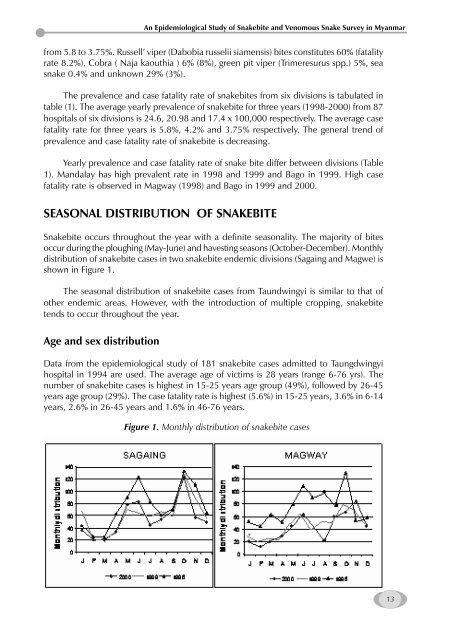Management of Snakebite and Research Management of Snakebite ...
Management of Snakebite and Research Management of Snakebite ...
Management of Snakebite and Research Management of Snakebite ...
You also want an ePaper? Increase the reach of your titles
YUMPU automatically turns print PDFs into web optimized ePapers that Google loves.
from 5.8 to 3.75%. Russell’ viper (Dabobia russelii siamensis) bites constitutes 60% (fatality<br />
rate 8.2%), Cobra ( Naja kaouthia ) 6% (8%), green pit viper (Trimeresurus spp.) 5%, sea<br />
snake 0.4% <strong>and</strong> unknown 29% (3%).<br />
The prevalence <strong>and</strong> case fatality rate <strong>of</strong> snakebites from six divisions is tabulated in<br />
table (1). The average yearly prevalence <strong>of</strong> snakebite for three years (1998-2000) from 87<br />
hospitals <strong>of</strong> six divisions is 24.6, 20.98 <strong>and</strong> 17.4 x 100,000 respectively. The average case<br />
fatality rate for three years is 5.8%, 4.2% <strong>and</strong> 3.75% respectively. The general trend <strong>of</strong><br />
prevalence <strong>and</strong> case fatality rate <strong>of</strong> snakebite is decreasing.<br />
Yearly prevalence <strong>and</strong> case fatality rate <strong>of</strong> snake bite differ between divisions (Table<br />
1). M<strong>and</strong>alay has high prevalent rate in 1998 <strong>and</strong> 1999 <strong>and</strong> Bago in 1999. High case<br />
fatality rate is observed in Magway (1998) <strong>and</strong> Bago in 1999 <strong>and</strong> 2000.<br />
SEASONAL DISTRIBUTION OF SNAKEBITE<br />
<strong>Snakebite</strong> occurs throughout the year with a definite seasonality. The majority <strong>of</strong> bites<br />
occur during the ploughing (May-June) <strong>and</strong> havesting seasons (October-December). Monthly<br />
distribution <strong>of</strong> snakebite cases in two snakebite endemic divisions (Sagaing <strong>and</strong> Magwe) is<br />
shown in Figure 1.<br />
The seasonal distribution <strong>of</strong> snakebite cases from Taundwingyi is similar to that <strong>of</strong><br />
other endemic areas. However, with the introduction <strong>of</strong> multiple cropping, snakebite<br />
tends to occur throughout the year.<br />
Age <strong>and</strong> sex distribution<br />
An Epidemiological Study <strong>of</strong> <strong>Snakebite</strong> <strong>and</strong> Venomous Snake Survey in Myanmar<br />
Data from the epidemiological study <strong>of</strong> 181 snakebite cases admitted to Taungdwingyi<br />
hospital in 1994 are used. The average age <strong>of</strong> victims is 28 years (range 6-76 yrs). The<br />
number <strong>of</strong> snakebite cases is highest in 15-25 years age group (49%), followed by 26-45<br />
years age group (29%). The case fatality rate is highest (5.6%) in 15-25 years, 3.6% in 6-14<br />
years, 2.6% in 26-45 years <strong>and</strong> 1.6% in 46-76 years.<br />
Figure 1. Monthly distribution <strong>of</strong> snakebite cases<br />
13









